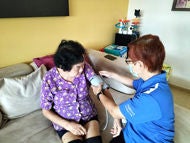What is - Shoulder Impingement

Shoulder impingement is a common problem, and subacromial impingement is the most common type. This occurs when the tendons of the muscles surrounding the shoulder (rotator cuff) rub under the surface of the acromion bone.
Repetitive arm movements, especially above 90 degrees, can irritate the subacromial bursa, a fluid-filled sac, causing it to become inflamed and swollen (bursitis). Thickened ligaments and bone spurs may also narrow the space for the tendons to move, thus increasing the risk of impingement and bursitis, especially in those with prior injuries or above the age of 40 years.
Symptoms of Shoulder Impingement
Symptoms include generalised pain in the region of the shoulder worsened by movement, especially with lifting of the arm above the shoulder or with the arm behind the back.
People with subacromial impingement may have difficulties with the following activities:
- Driving
- Putting on clothes
- Combing their hair
- Lying on the affected shoulder
Shoulder Impingement - Causes and Risk Factors
There are various reasons that can lead to the development of this condition. Subacromial impingement could be due to:
- Muscle imbalance. This refers to the tone or strength of the muscle around a joint and may be caused by unbalanced training regimes or poor technique.
- Mechanical reasons. Bone spur formation on the surface of the acromion, reducing the subacromial space and increasing the risk of impingement.
- Direct injury to the tendon.
Diagnosis of Shoulder Impingement
Besides a thorough history and physical examination to establish the cause, extent and severity of the problem, investigations such as x-rays, ultrasound scans, magnetic resonance imaging (MRI), or computed tomography
(CT) scans may be done to assess its severity and/or exclude injuries to the surrounding structures. This will also help with selecting the appropriate course of treatment.
Treatment for Shoulder Impingement
Patients with subacromial impingement often respond to non-operative measures and only a small proportion of patients will require surgery.
- Rest and painkillers. Initial treatment includes rest and modification of activities, and painkillers such as paracetamol or nonsteroidal anti-inflammatory drugs (NSAIDs).
- Physiotherapy. A physiotherapy programme aimed at improving strength and coordination of the rotator cuff may be useful.
- Corticosteroid injection. Sometimes, an injection of corticosteroid into the subacromial bursa may reduce inflammation.
Most people recover with rest and physiotherapy. If non-operative options fail, surgery may be considered.
Shoulder Impingement - Other Information
Activities to avoid
Patients with subacromial impingement should avoid activities that make the injury worse. These activities may include overhead throwing like tennis or basketball. It is also a good idea to avoid certain weightlifting exercises
that involve overhead movements.
Increase your training gradually and be mindful of the alignment of your shoulders and arms and exercise technique.
Contributed by
The information provided is not intended as medical advice. Terms of use. Information provided by SingHealth.
Get to know our doctors at SingHealth Hospitals in Singapore.
Get to know our doctors at SingHealth Hospitals in Singapore. here.




















